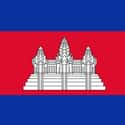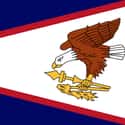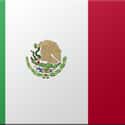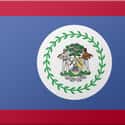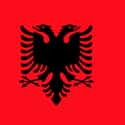-
(#5) Cambodia
- Phnom Penh
The Cambodian flag features two blue horizontal bands at the top and bottom, with a red band running across the center. The center of the banner features Angkor Wat, an ancient temple in Cambodia that is one of the largest religious monuments in the world.
This is the only flag in the world that depicts an actual real-world building, which shows how important Angkor Wat is to the country's culture and history.
-
(#10) American Samoa
The Samoan Islands were settled an estimated 2,000 years ago by Polynesian explorers. Fast-forward to the late 19th century when the colonial powers of the age were breaking the islands up into spheres of influence. The United States and Germany divided the islands between themselves in 1899, with American Samoa remaining an unincorporated territory to this day.
Until 1960, American Samoa flew the traditional Stars and Stripes. In creating its own flag, the territory looked to evoke American symbolism with its use of red, white and blue, and the inclusion of the American bald eagle. In a spin on the Great Seal of the United States, the flag's eagle holds in its talons two Samoan symbols of power: a battle club known as a fa'alaufa'i and a coconut fiber fly-whisk called a fue. These are supposed to represent America's guardianship over the territory.
-
(#4) Mexico
Americans may be familiar with Mexico's green, white and red flag, but many may not realize the eagle in the middle is actually eating a snake. The image, from Mexico's coat of arms, pays tribute to an Aztec legend. As the story goes, the wandering Aztec people were told to settle where they witnessed an eagle feasting on a writhing snake while sitting atop a cactus. The nomadic Aztecs supposedly saw this happen in the place where they founded Tenochtitlan, which is now Mexico City.
The colors of the flag hold great significance to the country. Green symbolizes hope, in the form of its fertile soile; white is for purity and the Roman Catholic religion; and red represents the blood shed for the nation's independence.
-
(#13) Belize
The flag of Belize features a blue background with thin red bands on the top and bottom edges, as well as the country's coat of arms. The coat features a circle of mahogany leaves, a shield, and two men standing beside a mahogany tree. The imagery honors the country's rich logging industry, which lead the English to settle there.
The motto inscribed on the coat of arms reads, "Sub Umbra Floreo," or, "I flourish in the shade." This is the only national flag that depicts human beings.
-
(#9) Isle of Man
This flag depicts three armored legs joined at the thigh and arranged in a circle. Based on the Celtic sun symbol known as the triskelion, the image is referred to as the Legs of Man. It is based on the coat of arms of the Norse King of Mann, a royal title held by multiple rulers between 1200 and 1500.
While it's unknown exactly how the Legs of Man came to represent the king on his coat of arms, they were adopted to represent the Isle of Man on the nation's flag in 1932. Before then, the country only used the Union Jack as a member of the British commonwealth. To this day, the Isle of Man's flag is still required to fly lower on the mast than the Union Jack.
-
(#8) Albania
While the Albanian flag might not contain as many colors or symbols as some of the other flags on this list, its bold choice of a blood-red background and a black, double-headed eagle make it stand out in a crowded field of bright hues and complex crests. The stark double-headed eagle is said to be the heraldic symbol used by the Albanian folk hero and warrior Skanderbeg, who led a violent rebellion against the Ottoman Empire. The revolt successfully (albeit temporarily) gained independence for the Albanians in the mid-1400s.
There is also a folkloric belief that Albanians are descendants of eagles, and the populace sometimes refer to themselves as Shqiptar, which translates to "Sons of the Eagle."
New Random Displays Display All By Ranking
About This Tool
Each country’s national flag has its unique and undisputed images and colors with cultural characteristics. The duty of any national flag is to pay tribute to the history and culture it represents. These specially designed flags show the rich and interesting characteristics of their respective countries. There are various explanations for the flag of each country. For example, Nepal has the only flag in the world that is not rectangular. The flag of Nepal is composed of two overlapping triangles, possibly representing the peaks of the Himalayas.
Do you remember any special countries' unique flags? Our random tool would introduce some surprising meanings of them, welcome to check the interesting collection and share this tool with friends.
Our data comes from Ranker, If you want to participate in the ranking of items displayed on this page, please click here.

